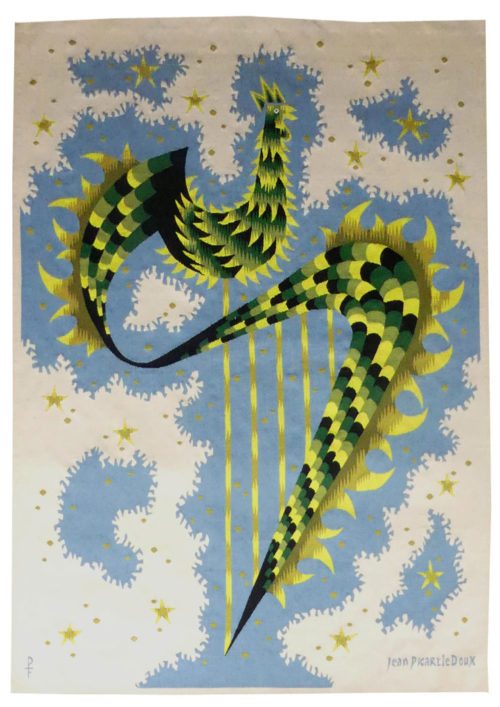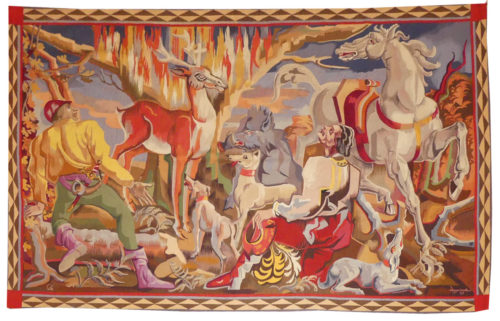La légende de Saint Hubert (the legend of Saint hubert)
Aubusson tapestry woven in the Pinton workshop for the Compagnie des Arts Français.
1943.
Adnet, who was placed at the head of the Compagnie des Arts Français in 1928, was keen to reinstate tapestry design as an art, distinct from painting, and a key element in interior decoration, with the constraint of numbered coloured threads (in a very similar approach to that of Lurçat). With this intention he contacted at the same time Despierre, Coutaud, Planson, and Brianchon. Despierre was particularly experienced in the conception of monumental art works (he also designed stained glass windows, mosaics and was a member of staff ,and then head, of mural art at the Ecole nationale des arts décoratifs), after receiving commissions during the war, he would be regularly asked to contribute cartoons to the Manufactures nationales who would go on to produce “la pêche” (fishing) “la chasse” (hunting) “le droit maritime”, (the law of the seas) “le droit industriel et commercial” (industrial and commercial law) through the 1950’s and 60’s.
The bright colours (the clothing of the man on the left, worthy of mannerism!), the dense and monumental style of the figures (typical both of the period and this artist’s personal style), should not be allowed to overshadow the underlying meaning of the tapestry : a religious subject, vector of faith and hope during a troubled period (Saint Saëns, Lurçat also dissembled the symbolic behind the apparent). A paradox if one considers the essentially decorative preoccupations of Adnet.
The Cité de la tapisserie in Aubusson possesses an inverted example of this tapestry, with a different border ; this is the one illustrated in the bibliography.
Bibliography :
Exhibition catalogue La tapisserie française du moyen âge à nos jours, Musée d’Art Moderne, Paris, 1946, n°247
Heng Michèle, Aubusson et la renaissance de la tapisserie, Histoire de l'art N° 11, 1990, Varia, Fig. 5 page 69
Exhibition catalogue Jean Lurçat, compagnons de route et passants considérables, Felletin, Eglise du château, 1992, ill. p.20-21
Exhibition catalogue Tapisserie et expressions du sacré, Aubusson, musée départemental de la tapisserie, 1999, ill. p.36
Exhibition catalogue Fantastiques chevauchées, le cheval en tapisserie, Aubusson, musée départemental de la tapisserie, 2008, ill.p.63



